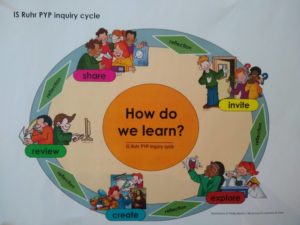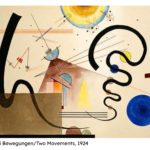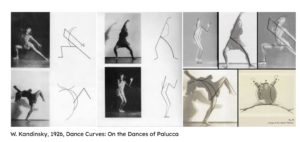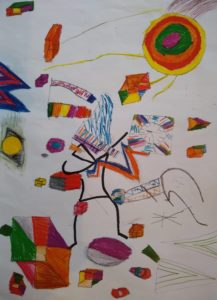This article is about a collaboration between music and visual art at IS Ruhr. The aim was to increase students’ conceptual understanding of the arts by exploring and connecting elements used in visual art, music, and dance. In this process students’ ATL skills and the IB learner profile were deepened.
After many conversations about the arts and our approaches to teaching, we, the music and art teacher at IS Ruhr, discovered a lot of overlaps in our fields and decided to collaborate.
The idea was to deepen a conceptual understanding of elements used in both art forms and their connection with each other, and in this transdisciplinary process achieve a new perception of the arts in general. These thoughts lead to the following central idea and lines of inquiry:
Central Idea
Connecting key elements in visual art and music transforms the way we perceive the arts.
Lines of Inquiry
- Exploring the reciprocal influence of music and visual art
- Using Elements of Art (EoA) and Principles of Design (PoD) in visual art analysis and Elements of Music (EoM) in music analysis
- Connecting EoA/PoD with EoM
- Creating and refining art based on new perspective
Key Concept
Perspective, connection, form, reflection
Related Concept
Self-expression (dance, play/improvise, draw/compose), exploration
A.T.L. skills
Thinking, communication, social
Learner Profile
Open-minded, communicator, balanced, thinker, knowledgeable, risk-taker, reflective
What and how students learned
Our main focus was to explore the way pieces of art are put together in our subject areas and to what extent components can be connected with each other. We followed the circle of inquiry collaboratively developed by the IS Ruhr PYP staff to structure students’ learning:
Invite
Students observed pieces of music and paintings, and expressed their thoughts/ideas/feelings about them.
Explore
Students explored EoA, PoD, EoM, learned to use them in describing visual art/music, and made connections between them.
Create
Students created drawings and improvisations in the process of acquiring a deeper understanding of the way visual art/music is built.
Review
Students discussed and refined their drawings/improvisations.
Share
Students have started compiling evidence of their learning on a website.
Learning steps
Step 1 (invitation): Focus on Wassily Kandinsky’s artwork
Questions (Provocations):
What do you see?
What do you hear?
What do you feel?
Selected student answers:
“I see moving lines.”, “The red circle is humming.”, “It feels like the shapes and lines are growing.”, “It’s like a foggy landscape. Blue is cold.”, “It’s a song!”
Students express their thoughts/ideas/feelings referring to the guiding questions, making connections to music (without prompting by the teacher).
straight lines = musical notation, strings from instruments, keys, tabs
curved lines = movements from conductor, of sound in space
interacting values = beats, expanding/fading sounds
repeating shapes and lines etc. = rhythm, dance
Step 2 (invitation):
Students listened to Arnold Schönberg’s atonal Three Piano Pieces Op.11 and expressed their feelings and observations. They learned about the friendship between W. Kandinsky and A. Schönberg and how they influenced each other’s art.
Step 3 (exploration/creation):
Kandinsky studied photographs of dancing poses, and invented new compositions, a line management capturing motion and expression of the dance.
Dynamic Pose (in Pairs)
Take pictures of each other dancing to your favourite music.
Transfer the digital image into an abstract drawing according to the examples below.
Step 4 (exploration/creation):
Visualize a piece of music
Take your favourite tune (pop song, classical piece etc.) and create abstract lines and shapes to represent it. Think of rhythm and melody, instruments that appear, the way it makes you move etc. Use Kandinsky’s paintings [01) & 02)] for inspiration. Combine this with the drawing of Step 3.
These abstract drawings were brought to the music room where students transformed them into sound.
Step 5 (exploration/creation):
Read drawings like a score
Transform your own or your classmate’s drawing into music by reading it like a score. Use an instrument of your choice and play together in a group. Describe the music you imagine before you play.
Questions: What kind of sounds do you imagine when looking at various EoA or PoD in the drawing? In what way would these elements/principles affect EoM used in your playing?
Selected Answers: Students made the following connections:
long lines = long, steady sounds (duration)
dots = short sounds (duration)
bright colours = high sounds (pitch)
dark colours = low sounds (pitch)
faded colours = quiet sounds (volume)
repetition of shapes = repetition of sounds (form)
a lot of squiggles = “chaotic” sounds (texture)
First students described the sounds in words and then improvised as a group.
Problem:
Even though students enjoyed playing together they were unhappy about the music not matching their imagination; probably due to a lack of communication in terms of when to play which element of the drawing.
Solution:
Play solos or duos: This alteration of the original task resulted in a musical outcome that was closer to their expectations.
Step 6 (creation/review)
Improvise, influenced by the drawing
Work alone or with a partner. Choose a drawing. Look at the drawing for a minimum of 30 seconds silently. Then close your eyes for 10 seconds. After that play and listen attentively to the sounds you are making.
Focusing on a more sensual approach students were encouraged to absorb the drawing by looking at it without analysing it in a specific way and then listen to their own playing attentively. Students should move away from the idea of reading the drawing like a score and rather let the art itself do the work.
Students’ response:
Students responded to this approach with enthusiasm and wanted to repeat the activity many times.
Step 7 (sharing):
Collaboratively create a website (with the help of the music teacher and art teacher) with recordings, images, photos of your drawings, comments and verbal explanations.
At this point our collaboration is not completed, but we are excited to see where it will take us.
Possible next steps:
- Share the website with a selected community (e.g. parents, other classes) and receive feedback.
- Perform improvisations and exhibit drawings as a school event.
- Explore the topic further with visits to museums, installations or concerts.
Reflections and Outlook
We enjoyed the transdisciplinary aspect of our collaboration and believe that our enthusiasm as teachers and artists had a positive impact. We accompanied our students’ learning with our own desire to acquire more knowledge about our colleague’s art form. We are still in the process of this inquiry and have a lot of ideas where it could lead. But we wouldn’t be part of the PYP if we weren’t prepared for the unexpected.
References and sources:
- line, color, shape/form, space, value, texture: https://www.thoughtco.com/what-are-the-elements-of-art-182704
- movement, rhythm, variety, composition, balance, unity, pattern, emphasis, proportion, contrast: https://artclasscurator.com/principles-of-design-examples/
- pitch, timbre, texture, volume, duration, form, spacial location: https://en.wikipedia.org/wiki/Elements_of_music
- https://interlude.hk/music-art-schoenberg-kandinsky/
- To the right: drawing by Noyan (ISRuhr, Grade 4)
- Image 3 – Wassily Kandinsky, “Dance Curves: On the Dances of Palucca” (1926) Dancer and choreographer Gret Palucca (1902-1993)
Daniel Niemann teaches visual art and is CAS coordinator at IS Ruhr. He studied visual art education and art therapy at Dortmund University. Apart from artistic activity he worked at different art museums, for arts festivals and has been teaching art for 20 years.









No comments yet.